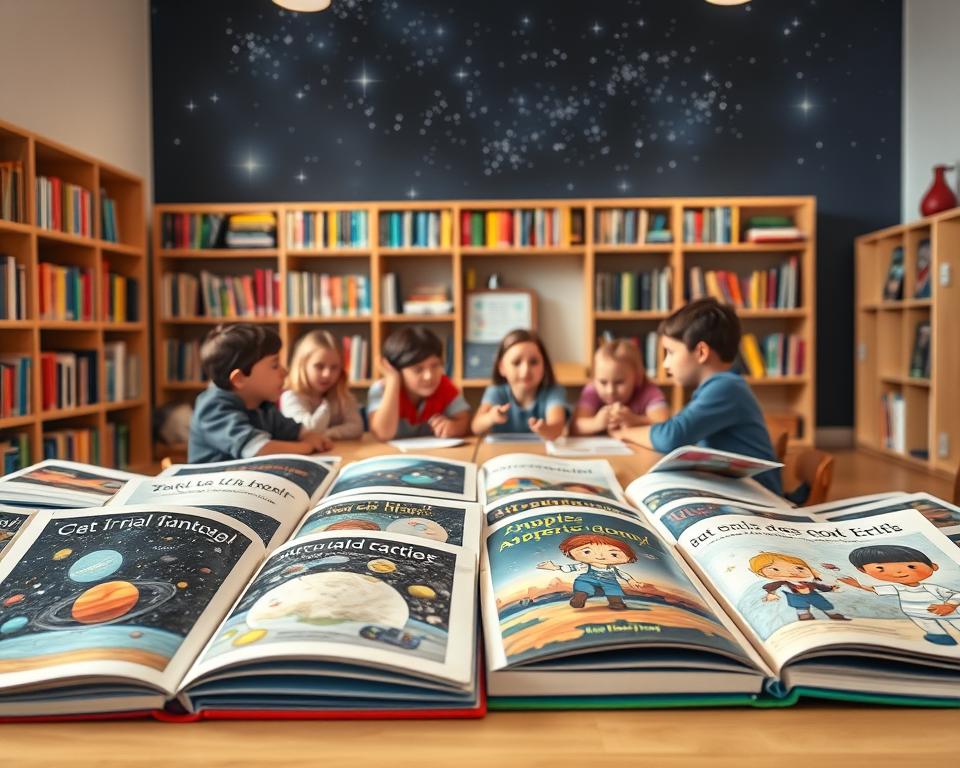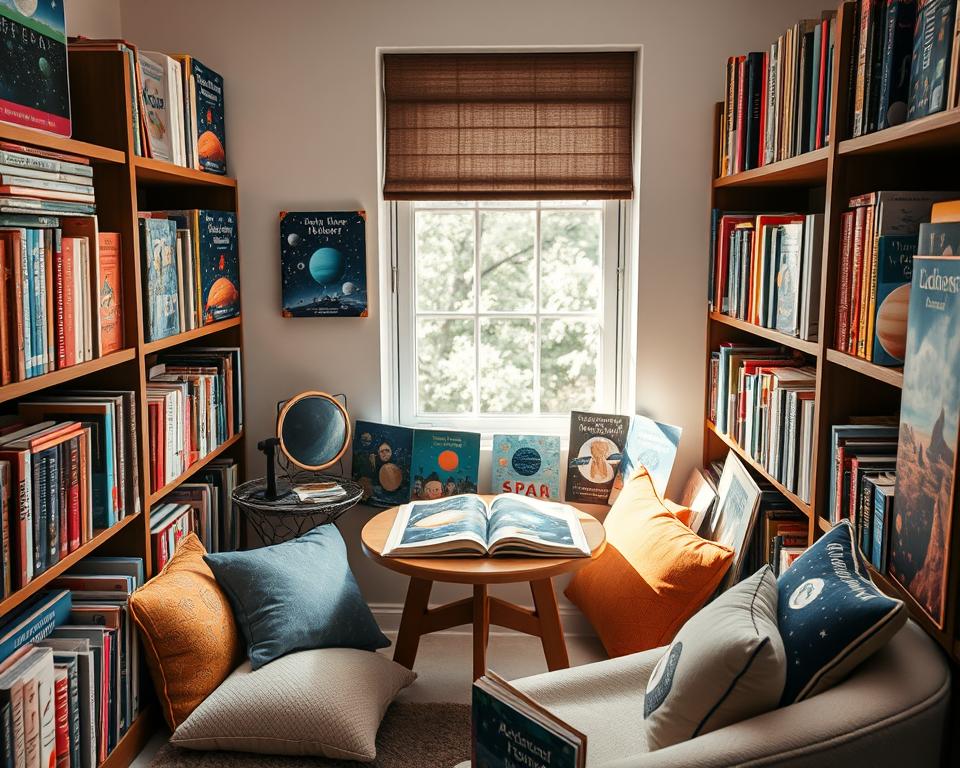I’ve created this guide to help parents and teachers find the best astronomy books for kids. There are over 40 books recommended for kids, covering 30 lessons. These books are for all ages and include everything from board books to encyclopedias.
Titles like “A Walk Through the Heavens” and Elaine Landau’s “True Books: Space” series focus on key concepts. They repeat these ideas to help kids understand better.
In India, there’s a growing interest in space, thanks to ISRO and backyard stargazing. This guide shows books that mix wonder with STEM learning. It includes affordable options like “The Mysteries of the Universe” (64% off) and activity books like “Astronomy Activity Book for Kids” (₹407), with 4.8/5 stars).
These books use pictures, hands-on projects, and discounts to make learning astronomy fun for all families.
Key Takeaways
- 40+ astronomy books cover topics from planets to myths, aligned with India’s space milestones.
- Top picks like “My Little Book of Planets” (₹150, 57% off) and “Encyclopedia of Space” (28% discount) offer affordable learning tools.
- Hemisphere-specific guides like “A Walk Through the Southern Sky” ensure cultural relevance for global learners.
- Libraries and Hoopla provide access to 85% of listed titles, reducing upfront costs for families.
- Interactive titles such as the ₹387 Qolixs 3D Solar System Crystal Ball combine play with science education.
What Is The Best Book For Childrens For Astronomy: Selection Criteria
Choosing the right astronomy book is key. It must match your child’s age, learning goals, and keep them interested. Look for children’s educational books on astronomy that fit their developmental stage and spark curiosity. Here are important factors to consider when picking from kids’ astronomy book recommendations and children’s space book reviews.

Age-Appropriate Content: Matching Books to Development Stages
For infants, Touch the Brightest Star is perfect (ages 0-3). It uses touch to teach. For kids aged 5-7, Eight Spinning Planets has fun plastic inserts. Older kids (8-12) will love Empires of Light, which tells the story of science in an easy way. Always check the age range the publisher suggests and adjust for your child’s interests.
Educational Value and Scientific Accuracy
Choose books that experts have checked, like The Astronomy Book: Big Ideas Simply Explained, made with NASA scientists. Stars and Planets: The Most Complete Guide (4.7/5) is great for young learners. Make sure to pick recent editions to avoid old theories.
Visual Appeal and Engagement Factors
Books with bright pictures are a hit with kids. Hubble’s Universe uses amazing telescope photos. Astronomy Activity Book for Kids (ages 5-7) has lots of fun activities. Books like ABCs of Space and Faces of the Moon make hard ideas easy to understand.
Durability and Print Quality Considerations
Young readers need books that can take a beating. Board books like Hello, World! Solar System are perfect. Spiral-bound books like 100 Things to See in the Night Sky (4.8/5) stay open for stargazing. Check reviews for how durable a book is—Watcher of the Skies is known for being sturdy.
| Book Title | Age Range | Key Features | Price | Rating |
|---|---|---|---|---|
| The Astronomy Book: Big Ideas Simply Explained | 8-12+ | 100+ concepts, NASA collaboration | $1.99 | 4.7/5 |
| Astronomy Activity Book for Kids | 5-7 | 100+ activities, durable pages | $8.10 | 4.8/5 |
| Stars and Planets: The Most Complete Guide | 6-12 | Scientific accuracy, 338+ reviews | $16.49 | 4.7/5 |
Top-Rated Astronomy Books That Captivate Young Minds
Here’s a list of the best astronomy books for young readers. They spark curiosity and teach knowledge. These books are fun and easy to understand. Parents in India can find them at local bookstores or online on Amazon India.

Beginner-Friendly Space Exploration Books
National Geographic Kids First Big Book of Space has bright pictures for preschoolers. Dr. Seuss’s There’s No Place Like Space is great for early readers. It uses rhymes to explain things simply.
The Magic School Bus Lost in the Solar System is perfect for kids aged 6–9. It mixes adventure with learning about the solar system.
Interactive Astronomy Books With Hands-On Activities
Astronomy Activity Book for Kids by Aurora Lipper has 100+ fun projects. Kids can make moon phases or track constellations. It also teaches how to use binoculars and introduces 25 celestial objects.
- Stargazing charts for beginners
- DIY planet models
- Star-spotting guides
Award-Winning Children’s Books About Our Solar System
Zoo in the Sky is an award-winning book. It mixes mythology with astronomy, telling stories of constellations through animals. The Mysteries of the Universe is a hit in Indian schools. It has over 100 entries on planets, black holes, and galaxies.
Both books are great for classroom activities.
Astronomy Books That Grow With Your Child
Find the Constellations is for kids aged 5–12. It starts with simple patterns and then moves to mythology. 50 Things to See with a Telescope is for all skill levels. It helps kids go from binoculars to detailed planet observation.
These books are useful as children learn more about astronomy.
Conclusion: Inspiring The Next Generation of Indian Astronomers
Popular children’s books about space open doors to wonder. Many families say these stories spark curiosity. One parent shared, “This book turned bedtime into a cosmic adventure.”
These moments show how books can mix learning with dreams. India’s Aryabhata, who figured out Earth’s rotation in 476 CE, would be proud of today’s young readers. They explore his legacy through the best astronomy books for young readers.
India’s journey in astronomy goes back thousands of years. From Aryabhata’s decimal system to Chandrayaan’s lunar missions, it’s a long path. His work in the Aryabhatiya, a 108-verse masterpiece, shows how today’s books make complex ideas simple.
The Bihar-based Aryabhatta Knowledge University keeps this tradition alive. It helps grow future scientists. Parents can take learning further by visiting planetariums in Mumbai or Delhi. Or, they can use apps like Star Walk to match what they read.
I suggest choosing books that mix stories with STEM. The best astronomy books for young readers are more than textbooks. They are keys to exploring the universe. Let kids follow Aryabhata’s steps through hands-on activities or stargazing.
India’s first satellite, named Aryabhata in 1975, shows every child’s curiosity can lead to great things. Encourage this wonder through books, city observatories, and local astronomy clubs. It’s where the next space pioneers start their journey.




